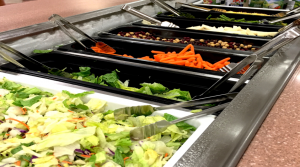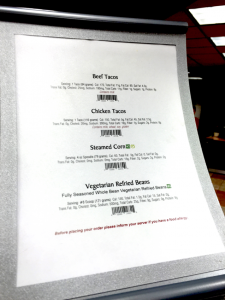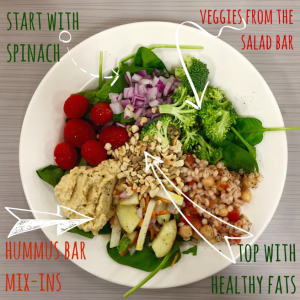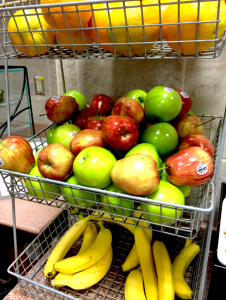Emily Block | Blogger
Whether you’re a returning student or it’s your first time at college, navigating the food court can be overwhelming. Most of us want to eat healthy, but don’t know where to start. Here are a few tips to keep your diet, and your freshman 15, in check.
Tip #1: Scoop the Loop
Take a couple of extra minutes to walk around the food court and survey your options. This will not only keep you from putting too much on your plate, but it will also give you ideas of how you might mix up the standard dishes. Some of my favorite meals here at school have utilized options from a variety of exhibitions. The food may start to seem repetitive, but with a little creativity, your diet doesn’t have to be.
Tip #2: One (Small) Plate at a Time
You’ve been in class since 9 AM. By the time lunch rolls around, you’re ravenous. You quickly scoop 20 chicken nuggets onto your plate and fill another with French fries before balancing a cup full of Pepsi on top of it all. If you eat too fast, you could very well consume your daily caloric allowance in 15 minutes.
To avoid situations like these, the best idea is to start with one plate (the smaller the better!). This way, you won’t overdo it on portion sizes and you’re likely to eat way less.
Tip #3: Watch your portion sizes
With the “all you can eat” set up of the cafeteria, it’s really easy to overdo your portion sizes. Sodexo actually displays all of the nutrition information on signs at the exhibitions. Take note of the recommended serving sizes to make sure you’re not eating to little or too much. This is also a great place to look if you have special dietary needs! Menu items that are vegetarian are marked with an orange “V” and vegan items are marked with a green “VG.” Common allergens are also listed, but it’s probably a good idea to double check with a worker if you’re unsure. In addition, the apple symbol designates a healthy option, making it super simple to make good nutritional choices!
Tip #4: Strive for Balance!
If you’re hungry within an hour of lunch or supper, odds are you didn’t have a balanced meal. Platefuls of pasta may seem like a good pre-game ritual, but in reality it’s just going to spike your blood sugar and leave you feeling drained. The best meals have a balance of all three macronutrients: protein, fat, and carbohydrates! With a variety of options in the food court, this balance is easy to attain regardless of your dietary preferences.
Here are some ideas to help you get started! Most of these are available in the food court on a daily basis:
Good protein sources: Lunch meat, chicken, beef, pork, turkey, beans, eggs, cottage cheese, milk, and chickpeas.
Good fat sources: Peanut butter, nuts and seeds, olive oil, hummus, and olives.
Good carbohydrate sources: Whole grain breads and pastas, quinoa, couscous, oatmeal, potatoes, vegetables, and fruits.
Aim to include at least one of the options from each category in every meal. Achieving this balance will help keep your energy levels up and hunger levels down, allowing you to stay focused through a long day of classes and activities.
Tip #5: Build a Better Salad
I find that the best way to get variety in my diet is to create salads with foods from all around the food court. Don’t limit yourself to the salad bar! Spinach and veggies are packed full of fiber and other micronutrients, chickpeas, hummus, and beans are a great non-traditional source of protein, and healthy fats like sunflower seeds and olive oil on top will keep you satisfied long into the afternoon. Avoid fatty dressings like ranch and Caesar, which can add hundreds of calories and tons of saturated fat to an otherwise healthy salad. If you need dressing, I’d suggest salsa, olive oil, or vinaigrette.
Tip #6: Eat this, Not that
One of the easiest ways to create a healthier meal is to make simple swaps. Some of my favorite swaps are:
• Use lettuce or spinach in place of a wrap, taco shell, or bun
• Use salsa instead of salad dressing
• Dip veggies in hummus instead of ranch
• Drink water instead of soda
• Whole grain bread instead of white bread
Tip #7: Prepare for a snack attack
The midday munchies are often unavoidable; listening to your hunger cues and eating when you are hungry is essential to supporting that fast metabolism we all desire. Keeping yourself sustained between meals will also keep hunger levels at bay and prevent you from overeating at your next meal. Grab a piece of fruit on your way out of the dining hall for a healthy (and cheap) midday snack.
*Additional tip: balance your snacks like you’d balance your meals! Eat fruit with yogurt or peanut butter for extra sustainability.
Tip #8: Treat yourself! (But not too often)
I’ll be honest- I’m a sugar junkie. When I went to Iowa State, they rotated the frozen yogurt flavors daily; not to mention the hand dipped Blue Bunny ice cream counter that was included with our meal plan. Thank goodness I don’t have access to that anymore!
The point is, it’s really easy to make dessert part of your daily meal routine, especially when it’s so easily accessible. However, desserts are often packed with sugar that can cause your blood sugar to spike real quickly—not to mention all of the additional (and probably unnecessary) calories you’ll accumulate over time.
Don’t deprive yourself of desserts, as this will just make you want them more. Instead, set a limit! Having the mentality that the dessert will always be there will make it easier for you to make healthier choices on a daily basis. This may be “Ice cream on Fridays!” or saving your sweet splurges for apple crisp. Again, watch your portion sizes.
It may seem super complicated, but eating healthy at college isn’t as hard as you think. Making a few simple swaps and keeping your portions in check will go a long way as you work toward a healthier lifestyle.
Emily













